Insecticidal composition containing diflubenzuron and deltamethrin and application thereof
An insecticidal composition, deltamethrin technology, applied in the direction of insecticide, application, biocide, etc., can solve the problem of no compounding of diflubenzuron and deltamethrin, achieve excellent control effect and reduce pesticides Dosage and cost, effect of reducing residue
- Summary
- Abstract
- Description
- Claims
- Application Information
AI Technical Summary
Problems solved by technology
Method used
Image
Examples
example 1
[0024] Physical measurement example 1: Toxicity determination of diflubenzuron and deltamethrin complex against tea geometrid
[0025] 1. Test object: tea inchworm [Latin scientific name: EctropisobliquehypulinaWehrli ], belonging to Lepidoptera Geometridae.
[0026] 2. Test method: Refer to the "Indoor Bioassay Test Guidelines for Pesticides NY / T1154.2-2006", using the poisonous leaf method.
[0027] 3. Data statistical analysis: use SAS statistical software for analysis. Calculate the mycelial growth inhibition rate (%) according to the test data, and calculate the virulence regression equation, correlation coefficient (r), EC 50 and co-toxicity coefficient.
[0028] 4. Evaluation method: Refer to the "Indoor Bioassay Test Guidelines for Pesticides NY / T1156.7-2006", and evaluate the synergistic effect of the mixed use of pesticides according to the co-toxicity coefficient method (CTC) of Sun Yunpei's method (1960), that is, CTC≤80 is Antagonism, 80<CTC<120 is additive e...
example 2
[0034] Physical Test Example 2: Determination of the Toxicity of Diflubenzuron and Deltamethrin Compound to Peach Borer
[0035] 1. Test object: Peach borer [Latin scientific name: Conoethes punctiferalis ], belonging to Lepidoptera Mothidae.
[0036] 2. Test method: refer to "Pesticide Indoor Bioassay Test Guidelines NY / T1154.8-2007", and use the filter paper membrane method.
[0037] 3. Data statistical analysis: use SAS statistical software for analysis. Calculate the mycelial growth inhibition rate (%) according to the test data, and calculate the virulence regression equation, correlation coefficient (r), EC 50 and co-toxicity coefficient.
[0038] 4. Evaluation method: Refer to the "Indoor Bioassay Test Guidelines for Pesticides NY / T1156.7-2006", and evaluate the synergistic effect of the mixed use of pesticides according to the co-toxicity coefficient method (CTC) of Sun Yunpei's method (1960), that is, CTC≤80 is Antagonism, 80<CTC<120 is additive effect, CTC≥120 i...
example 3
[0044] Physical measurement example 3: Toxicity determination of diflubenzuron and deltamethrin complex on citrus leaf miner
[0045] 1. Test object: citrus leaf miner [Latin scientific name: Phyllocnistis citrella Stainton ], belonging to Lepidoptera Lepidopteridae.
[0046] 2. Test method: Refer to the "Indoor Bioassay Test Guidelines for Pesticides NY / T1154.6-2006" and use the method of soaking insects.
[0047]3. Data statistical analysis: use SAS statistical software for analysis. Calculate the mycelial growth inhibition rate (%) according to the test data, and calculate the virulence regression equation, correlation coefficient (r), EC 50 and co-toxicity coefficient.
[0048] 4. Evaluation method: Refer to the "Indoor Bioassay Test Guidelines for Pesticides NY / T1156.7-2006", and evaluate the synergistic effect of the mixed use of pesticides according to the co-toxicity coefficient method (CTC) of Sun Yunpei's method (1960), that is, CTC≤80 is Antagonism, 80<CTC<120 ...
PUM
 Login to View More
Login to View More Abstract
Description
Claims
Application Information
 Login to View More
Login to View More - R&D
- Intellectual Property
- Life Sciences
- Materials
- Tech Scout
- Unparalleled Data Quality
- Higher Quality Content
- 60% Fewer Hallucinations
Browse by: Latest US Patents, China's latest patents, Technical Efficacy Thesaurus, Application Domain, Technology Topic, Popular Technical Reports.
© 2025 PatSnap. All rights reserved.Legal|Privacy policy|Modern Slavery Act Transparency Statement|Sitemap|About US| Contact US: help@patsnap.com



